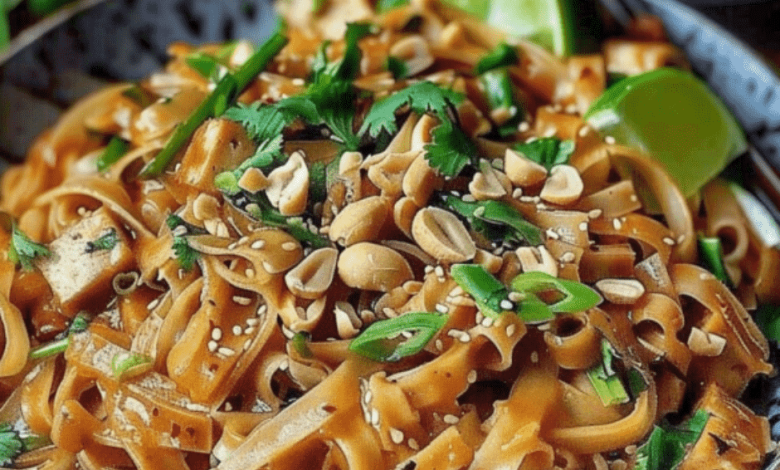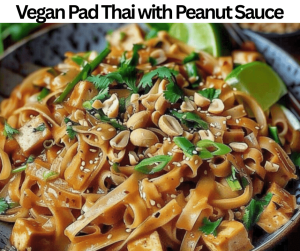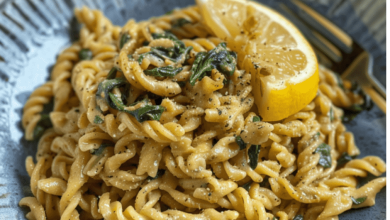Vegan Recipes
Pad Thai with Peanut Sauce


This colorful, flavorful, and filling vegan Pad Thai with Peanut Sauce elevates simple rice noodles and vegetables to the level of a restaurant meal. In this plant-based version, fish sauce and eggs are replaced with a creamy, nutty peanut sauce that is sweet, salty, tangy, and just spicy enough. Every bite of this vegan Pad Thai with Peanut Sauce is the perfect balance of flavor and texture, with crunchy peanuts, tofu, and fresh vegetables. After trying this vegan favorite at home, you’ll never go back to takeout.
QUICK OVERVIEW
- Cuisine of the dish: Thai-inspired, Asian fusion
- Size of a portion: ~2 cups/serving
- Cook time: Twenty minutes
- Time or prep: Fifteen(15) minutes
- Active working time(total): Thirty-five(35) minutes Course: Main
- Diet category: Vegan
- Yield: Serves four
- Complexity level: Simple to moderate
TOOLS
- Spatula or tongs
- Measuring spoons
- Whisk
- Deep skillet or large wok
- Cutting board
- Measuring cups
- Knife
- Mixing bowls(for sauce and noodles)
INGREDIENTS
PAD THAI
- Cilantro and lime wedges for garnishing
- 8 ounces of rice noodles
- Roasted and chopped peanuts, half a cup
- 1 tbsp. of sesame or vegetable oil
- Soy sauce, one tbsp.
- A block of 14 ounces of tofu
- 2 cloves of minced garlic
- One cup of carrots
- 3 green onions
- Bean sprouts, one cup
- 1 bell pepper, red
PEANUT SAUCE
- Fresh lime juice, one tbsp.
- 3 tbsp. of soy sauce
- Warm water, 2-3 tbsp.
- 1/3 cup of peanut butter
- Sriracha or chili paste, one to two tbsp.
- 2 tablespoons of rice vinegar
- Agave or maple syrup, one tbsp.
INGREDIENT NOTES
SOY SAUCE
- It adds umami flavor to your sauce and pad thai. Coconut aminos should be used as a soy-free alternative, while tamari is suitable for a gluten-free diet.
TOFU
- Use pressed and cubed firm tofu for frying. To crisp it up, press it well to remove all of the moisture. Try edamame or tempeh instead of tofu for a change.
VEGETABLES
- We are using shredded carrots, chopped green onions, sliced bell peppers, and bean sprouts in our dish. These veggies make the dish filling, nutrient-rich, crunchy, and visually appealing. You may swap these veggies with broccoli, zucchini, snap peas, etc., as per your choice or availability.
RICE NOODLES
- Using flat rice noodles with a medium width serves as the base of our dish. Never overcook them; otherwise, they become too soft and mushy. You may use soba or brown rice noodles instead.
SRIRACHA OR CHILI PASTE
- It’s an optional ingredient that adds spice to the dish for spice lovers. If you like mild spice, then use a little or skip them entirely.
PEANUT BUTTER
- Use the natural peanut butter without additional oil or sugar for a nutty flavor or creamy texture. Cashew and almond butter may also work instead of peanuts.
SWEETENER
- We are using the maple syrup to balance the sauce with gentle sweetness. Coconut sugar or agave syrup also works instead of maple syrup.
INSTRUCTIONS
- Pour salted water into a large pot.
- Place the pot on stovetop.
- Add the rice noodles to it once the water starts boiling.
- Tender the noodles as directed on the packet.
- Then, to stop them from cooking, strain them and wash them with cold water.
- Whisk all the sauce components in a bowl.
- Gradually, one tablespoon of warm water at a time should be added until the ideal consistency is reached.
- Taste the sauce to check and add if you feel the need for more of the maple syrup, soy sauce, or lime.
- Now your peanut sauce is ready.
- Place the wok over a moderate flame with sesame oil in it.
- Add the tofu cubes once the oil gets heated.
- Fry them while changing their sides occasionally, till the tofu cubes crisp and brown.
- Dish them out after frying and add a little more oil to that same skillet.
- Sauté the carrots, garlic, and bell peppers for some four minutes.
- Then, add green onions and bean sprouts and saute for sixty seconds more.
- Now, add the cooked and drained rice noodles, peanut sauce, and fried tofu to the sauteed veggies.
- Mix them well till all are evenly coated with the sauce, and mix properly.
- Warm for 03-04 minutes and divide into four serving bowls.
- Serve this vegan Pad Thai with Peanut Sauce, chopped peanuts, cilantro, or lime as a garnish.
TIPS
- Roll the tofu cubes in a little cornstarch and dust off the excess before frying. This makes your fried tofu extra crispy.
- The peanut sauce is something you can prepare ahead of time and keep chilled. This will make your work easier
- If you feel the noodles are sticky, mix them with sesame oil.
- Avoid overheating the peanut sauce; otherwise, it will become too thick.
STORAGE DIRECTIONS
FRIDGE
- Pack the remaining pad thai upon complete cooling in a tightly locked container to keep it fresh for 04-05 days.
FREEZER
- Pack the udish as directed above using the freezer-friendly container and keep it frozen for 60-70 days. Move the box of frozen pad thai to the fridge 24 hours earlier to defrost
REWARMING
- Add the defrosted or chilled dish to the skillet with some water and heat gently on the stove while stirring occasionally.
FAQs
Will the pre-baked or smoked tofu work?
- Yes, they save your time, and smoked tofu adds a smoky twist.
Which sides complement vegan pad Thai the best?
- Miso soup, spring rolls, fresh cucumber salad, etc., pair well with this dish.
Can I replace peanut butter?
- You may use cashew, almond, or sunflower seed butter instead of peanut butter.
Is that possible to go gluten-free with this dish?
- Yes, as rice noodles are naturally gluten-free, you only need to swap soy sauce with tamari, and your dish will be perfectly suitable for celiac patients.
NUTRITIONAL FACTS PER SERVE
Calories per portion: ~420 kcal per serve
Total carbs: 54 g
Fiber: Five grams
Net carbs: Forty-nine grams
Proteins: 16 g
Fats: Seventeen grams
Sodium: 590 mg
Size of a portion: 02 cups
Sugar: Nine grams




